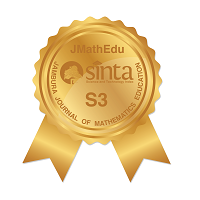Pengaruh Penggunaan Power Point Berbasis Animasi terhadap Hasil Belajar Siswa pada Materi Dimensi Tiga
Abstract
Keywords
Full Text:
PDF [Indonesia]References
Suryosubroto, "Proses Belajar Mengajar di Sekolah" in PT Rineka Cipta, 2009.
S. B. D. dan A. Zain, "Strategi Belajar Mengajar. Jakarta: PT Rineka Cipta" Syaiful Bahri Djamarah dan Aswan Zain, 2006, doi: 10.1016/j.bbapap.2013.06.007.
V. Damopolii, N. Bito, and R. Resmawan, "Efektifitas Media Pembelajaran berbasis Multimedia pada Materi Segiempat" Algoritm. J. Math. Educ., vol. 1, no. 2, pp. 74-85, 2019, doi: 10.15408/ajme.v1i1.
D. Wungguli and L. Yahya, "Pengaruh Penggunaan Media Berbasis Information and Communication Technology (ICT) terhadap Hasil Belajar Siswa pada Materi Dimensi Tiga" Jambura J. Math. Educ., vol. 1, no. 1, pp. 41-47, Mar. 2020, doi: 10.34312/jmathedu.v1i1.5376.
B. DePorter, M. Reardon, and S. Singer-Nourie, Quantum Teaching: Mempraktikkan Quantum Learning di Ruang-ruang Kelas. Bandung: Kaifa, 2007.
M. Aly, J. Elen, and G. Willems, "Instructional multimedia program versus standard lecture: a comparison of two methods for teaching the undergraduate orthodontic curriculum" Eur. J. Dent. Educ., vol. 8, no. 1, pp. 43-46, Feb. 2004, doi: 10.1111/j.1600-0579.2004.00315.x.
C. F. de Wet, "Beyond Presentations: Using PowerPoint as an Effective Instructional Tool" Gift. Child Today, vol. 29, no. 4, pp. 29-39, Oct. 2006, doi: 10.4219/gct-2006-8.
D. Borboa, M. Joseph, D. Spake, and A. Yazdanparast, "Perceptions and Use of Learning Management System Tools and Other Technologies in Higher Education: A Preliminary Analysis." 2014.
R. Masykur, N. Nofrizal, and M. Syazali, "Pengembangan Media Pembelajaran Matematika dengan Macromedia Flash" Al-Jabar J. Pendidik. Mat., vol. 8, no. 2, p. 177, Dec. 2017, doi: 10.24042/ajpm.v8i2.2014.
P. A. Damayanti and A. Qohar, "Pengembangan Media Pembelajaran Matematika Interaktif Berbasis Powerpoint pada Materi Kerucut" Kreano, J. Mat. Kreat., vol. 10, no. 2, pp. 119-124, Dec. 2019, doi: 10.15294/kreano.v10i2.16814.
T. Davies, F. Division, and F. Division, "Non-classroom Use of "˜ Presentation Software ' in Accelerated Classes : Student Use and Perceptions of Value."
DOI: https://doi.org/10.34312/jmathedu.v1i2.7325
Refbacks
- There are currently no refbacks.
Copyright (c) 2020 Jambura Journal of Mathematics Education

This work is licensed under a Creative Commons Attribution-NonCommercial 4.0 International License.
Jambura Journal of Mathematics Education has been indexed by:
EDITORIAL OFFICE OF JAMBURA JOURNAL OF MATHEMATICS EDUCATION |
 | Department of Mathematics, Universitas Negeri Gorontalo Jl. Prof. Dr. Ing. B. J. Habibie, Moutong, Tilongkabila, Kabupaten Bone Bolango, Gorontalo 96554, Indonesia |
 | Email: [email protected] |
 | +6285255745923 (Call/SMS/WA) |
 | Jambura Journal of Mathematics Education (JMathEdu | eISSN: 2721-7477) by Department of Mathematics Universitas Negeri Gorontalo is licensed under a Creative Commons Attribution-NonCommercial 4.0 International License. Powered by Public Knowledge Project OJS. |



















